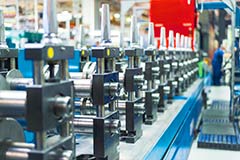
Manufacturing engineers play an indispensable role in designing, developing, and managing industrial production processes. These efforts have helped streamline operations and enabled factories to:
- Incorporate new technologies
- Identify sources of waste
- Evaluate quality control procedures
- Manage inventory
- Meet difficult safety and regulatory standards
- Eliminate errors
- Perform new test methods
- Redesign equipment
- Draft plans for all procedures
- Analyze production schedules
- Reappraise materials
- Improve manufacturing efficiency
- Minimize downtime
- Educate workforce
- Create procurement strategy
- Preventive maintenance
Master Bond high performance liquid/paste and film adhesive systems are capable of being employed by manufacturing engineers to produce top-quality, consistent, repeatable, reliable, and long-lasting products expeditiously. They consist of epoxies, silicones, urethane modified epoxies, cyanoacrylates, and UV/visible light curing systems. These durable adhesives are able to provide many advantages in comparison to brazing, welding, mechanical fastening. Bonding agents exhibit significant strength characteristics, adhere well to similar/dissimilar substrates, remove the need to drill holes, resist dynamic forces, chemical attack, humidity, low/high temperatures and adhere well to thin surfaces. Additionally, they provide even distribution of stress, protection from corrosion, bond/seal simultaneously, have low shrinkage, will not distort substrates, reduce weight, and deliver notable aging properties. Conductive and non-conductive systems are available for use in large, medium, and small volumes.
Manufacturing engineers possess superb skills in solving problems. They are acknowledged for their ability to evaluate, detect, troubleshoot, and prevent substantial production processing issues. Master Bond has been at the forefront in providing assistance to manufacturing engineers in rectifying adhesive dilemmas. These systems have been utilized in projects involving robots, automatic packaging machines, vision inspection cameras, solar energy panels, environmental controls, 3D printers, fabrication of microdevices, material handling equipment, satellite manufacturing, and prosthetic device assembly.

